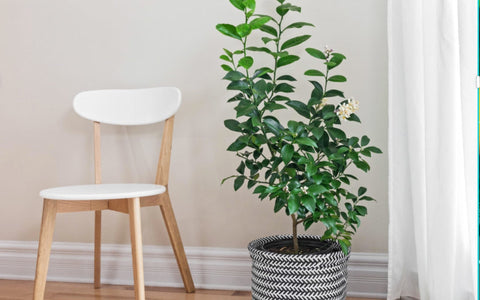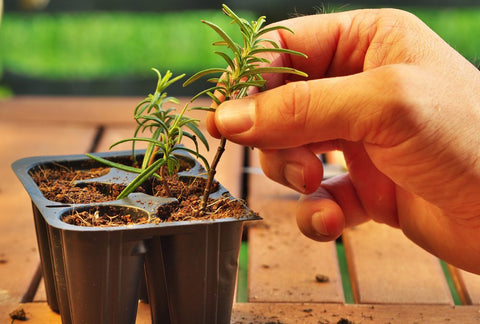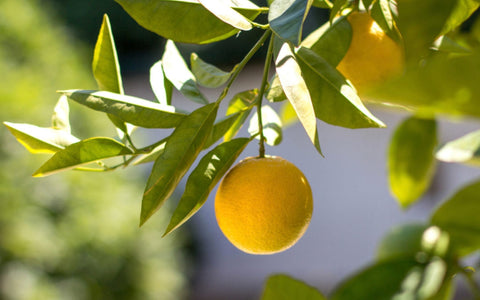We know you’re all curious about growing fruit trees in containers, so we decided to write a whole article for you. This guide provides a complete overview to selecting a container, starting soil, and establishing a good watering and fertilizer schedule. You’ll also need a good lighting setup for fruit trees and fruit tree gardening skills, if you want to round out your research before growing.
Can You Grow Fruit Trees in Pots or Containers?
A surprising amount of fruit trees can be grown in pots or containers - it’s a trick that outdoor growers use to grow tropical fruits in cooler climates (they bring the plants inside for the winter). Naturally tree roots are able to extend as deep or wide as they like to access nutrients and water. In containers we make up for the lack of space by creating near-perfect conditions in the soil we do have.
What’s the best planter set-up for fruit trees
The indoor container has a big task – it’s got to provide a suitable replacement for expansive earth. However a well selected and tended planter can provide just what’s needed to make fruit and keep the plant to an indoor appropriate size. When considering a container from existing options there’s a balance between how often you’ll need to water it, if you will need to manually root prune, and how it looks. Our dream container is a nice looking planter that is air-pruning + self-watering. This doesn’t exist (yet…), but you can get good options for other air pruning pots and passive watering.

Planter size: Are Big Pots Best for Fruit Trees?
The biggest decision you’ll make is the size of the planter – it will determine how large your plant will grow and how often you have to water it. Big pots are not always the perfect pot for your fruit tree. When placed in a bigger pot, plants tend to focus their energy on filling the new space with roots. If you are happy with your tree size, and would rather it focus its energy on making fruit best to not size up. Also, big pots are a bit cumbersome. By using more concentrated nutrients and consistent watering (more on both of those below) you can get away with a smaller pot than is often recommended, which is good… a 25+ gallon container can be cumbersome.

Understanding free draining vs. Self watering planters
Fruit trees have a bit of a love-hate thing with water, they don’t like their soil to dry out…but they’re prone to disease if it’s too soggy. For this reason, we don’t recommend wicking-based self-watering for any fruit trees. Ceramic-based self-watering planters can be managed to keep the soil moist but not soggy (the only option large enough for small trees is the 1.5-gallon Wetpot). Generally, our preference is to use a free-draining pot, give a deep watering, then wait until the top inch of soil dries out – typically around once a week. The watering schedule becomes more frequent as the plant grows, so we recommend adding ceramic watering spikes to keep things on a weekly schedule.
Growing Citrus in Self Watering Tree Pots: Is it recommended?
As explained above, we prefer not to grow citrus or other fruit trees in self-watering tree pots, as they tend to have a bit of a love-hate relationship with water. We recommend using Free Draining planters for your citrus or any other fruit trees.
Air-pruning pots: Let your fruit tree do the pruning for you
Tree roots “search” by their nature. In smooth-walled containers this leads to the roots circling around the edge and if left unchecked can cause the plant to choke itself. While many people are content removing and pruning the roots once a year, you can also get pots that automatically do it for you. The technique of “air pruning” works by directing the roots to openings in the pot that are exposed to air. When the root encounters the constantly dry area, its tip is “pruned”. There are several options that will help keep your root structure healthy with no extra work (though none of them are particularly attractive). Options include air pots and fabric pots (though the fabric pots tend to go through the water quickly).
Best and Most Recommended Large Pots for Fruit Trees
Both us and experplantman.com recommend the following large pots for your fruit trees:
| Pots for Fruit Trees | Rating |
| Self Watering Drainage Pot | 10/10 (Editor's Choice) |
| TIMEYARD Woven Cotton Planter | 9/10 |
| Plastic Black Nursery Pot | 9/10 |
| Gardzen 30 Gallon Grow Bags | 8/10 |
| Terracotta Round Garden Planters | 8/10 |
| Mkono Plastic Orchid Pots | 9/10 |
What’s The Best Soil for Fruit Trees in Pots?
The top priority is the soil stays sufficiently aerated for the life of the plant – this means it needs to have good spaces for air and be able to freely drain when watered. It’s a topic that you can dig deep into but good soil needs to have fairly large particles (it’s not good when peat or coco coir is the first ingredient). For the fruit trees that are especially susceptible to soggy roots mixtures sold for cactus, palms and citrus are best. Fruits that can handle a little more organic matter, as is the case with basic potting mixes, do better with a richer standard potting mix. The table at the end of this blog
Plants that prefer free-draining mixtures:
Lemon, Lime, Orange, Avocado, Olive, Pineapple
Plants that prefer rich potting mix:
Fig, Peach, Strawberry, Banana, Coffee
What’s The Best Fertilizer for Fruit Trees in Pots?
When working to provide the same resources in a smaller space, we need to be careful of over-providing, as there’s a narrow range between deficiency and toxicity with many nutrients. If your soil does not have nutrients, it’s good to start with an initial charge of slow-release fertilizer. In general fruit trees are heavy to moderate feeders, but each plant has different requirements. Fortunately, two types of fertilizer cover all fruit trees – a “High N” mix for Temperate & Tropical plants and a “Low P” mix for the Subtropical Plants. Follow the schedule closely – once every three months for the slow-release fertilizer we recommend (compared to a water-soluble or granular source) – and your plant will be able to make the most out of its small container!
Fruit trees that prefer “Low P” fertilizer:
Lemon, Lime, Orange, Avocado, Olive
Fruit trees that prefer “High N” fertilizer:
Fig, Peach, Strawberry, Banana, Coffee, Pineapple











There are no comments for this article. Be the first one to leave a message!